Military. Later, general, acute
Shortly after the outbreak of WW1 the Government of Ontario set apart C$2m - a huge amount of money at that time - as a War Relief Fund, with the intention of sending comforts to Canadian troops in camps in England or actively engaged at the front in France. As there was money to spare, the Agent-General for Ontario, Lt.-Col. Richard Reid, was sent to France to look into the matter. He recommended that a military hospital be established somewhere between London and the South Coast.
The 70-acre Boundary Estate at Orpington was eventually chosen for the new hospital. It was 15 miles from London and lay southeast of the station, which was on the main South-Eastern railway line from Dover to Folkstone. (The War Office's original site of choice had been in Ely Road, Cambridgeshire, but the architect had rejected this as the sewage overflow for the City of Cambridge was nearby).
Construction work began in October 1915 and was completed four months later.
The Ontario Military Hospital opened on 19th February 1916. Patients were admitted from the end of April onwards via the Out-Patients Department, where those who were able had baths and left their clothes (stretcher cases were passed through). Although the majority were Canadian, troops from Britain and the British Empire - Newfoundland (then a British colony), Australia, New Zealand - as well as from the Allied forces were also received.
The Hospital, set on a gentle slope, consisted of hutted wards which were built from timber and asbestos sheeting mounted on dwarf brick walls. The huts had windows on both the long sides and, at the far end, a French window which overlooked the Kent countryside. The huts were built opposite each other, at right-angles to a connecting corridor. Each of the 20 wards could accommodate 52 patients, giving a total of 1,040 beds.
The Hospital was staffed by Canadian nurses and medical personnel from the Canadian Army Medical Corps. One of the surgeons, Thomas McCrae (1870-1935), was an early pioneer of plastic surgery for severe facial injuries (his brother Major John McCrae (1872-1918), also a military doctor, wrote the celebrated poem In Flanders Fields). The Hospital was one of the first to establish occupational therapy for patients with shell shock.
By the end of 1916 it was recognised that there was insufficient hospital accommodation for the Canadian Forces in the British Isles, and the Director of Medical Services asked the Canadian Dominion Government if the accommodation at the Ontario Military Hospital could be doubled. The Government agreed, and the extra wing with 1,040 beds was added to the site. It was ready for occupation in July 1917.The long wards, with their walls painted green, each contained 46 beds. Each bed had a white counterpane and two pillows. Each ward had a bathroom, kitchen, linen cupboard and utility room. The Sister's Room had a large window, through which the whole ward could be kept under observation. Huts also contained the various departments - dental, throat, nose and ear, and eye - which were connected by roofed walkways. The operating theatre had four operating tables.
Each of the wings had two serveries, from which meals were dispensed to the wards. There were pack stores, milk stores and meat stores, as well as a newspaper stand, a barber's shop and a post office. The site also contained a mortuary chapel.
The nursing staff were housed in large huts, which had two sitting rooms, a writing room, mess room and a servery. The Sisters each had a room in their hut, with Matron's quarters at one end. This hut also had a common sitting room, a rest room, a writing room and a mess room and servery, for them to run their own mess, with a separate kitchen and kitchen staff.
The Medical Superintendent's residence was Boundary House, the mansion house to the Estate.
On 10th September 1917 the Hospital was reorganised as the No. 16 Canadian General Hospital.
By January 1919 more than 25,000 wounded troops had been treated at the Hospital. Only 182 (less than 1%) died; most are buried in the 'Canadian Corner' of the nearby All Saints' Church graveyard.
The Hospital was finally demobilised on 20th September 1919, when it came under the control of the Ministry of Pensions. It then provided treatment and care for 1000 disabled ex-servicement and was staffed by the Ministry of Pensions Nursing Service (MPNS). The nurses wore a grey uniform and a white cap of hem-stitched muslin with the monogram MPNS embroidered on it. A blue belt was also worn. Three stripes denoted an Assistant Matron and two a Charge Nurse. Patients were classified as medical (for example, heart disease, tuberculosis, bronchitis, asthma), surgical or enteric. There was also a section for tropical diseases, such as malaria, dysentery and sprue.
The Hospital eventually became the Orpington Hospital, a municipal general hospital for the local population. A new wing was built in 1939, just before the outbreak of WW2. The Hospital became an Emergency Medical Service Hospital during the war, admitting evacuees from Dunkirk at the end of May, 1940.
It joined the NHS in 1948 as the Orpington Hospital, under the control of the Orpington and Sevenoaks Group Hospital Management Committee, part of the South East Metropolitan Regional Hospital Board. It had 1,090 general beds.
The number of beds gradually reduced as the old wooden huts were demolished. By 1951 there were 993 beds and, by 1955, 645 beds. A Casualty Department opened in 1956, but the number of beds continued to decline and, by 1964, there were 550.
Following the NHS reorganisation in 1974, the Hospital came under the Bromley Area Health Authority, part of the South East Thames Regional Health Authority.
By 1979, when most of the hutted wards had been demolished, work began on the erection of the new Canada Wing. The Clock Tower, which dated from WW1, was removed from its location on top of the Reception hut and placed in the car park outside the 1939 extension (where it fell into disrepair).
The £7.8m Canada Wing was officially opened in 1983 by the Canadian High Commissioner. The building contained the Out-Patients Department, operating theatres and five wards (two of which were named after Canadian Provinces - Ontario and Quebec - and one after the 10th Canadian Prime Minister - Mackenzie King). The Hospital now provided the full services of a modern district general hospital, including an Accident and Emergency Department.
In 1990 the Hospital had 400 beds, but plans for further development ceased when the Area Health Authority decided to build a new central hospital in Bromley to cover the whole district. Despite vigorous local opposition and campaigning, the A&E Department closed and, in 1997, almost half the land was sold for housing development. By 1998 the Hospital had only 113 beds. Ironically, the plan for the Bromley hospital never materialised and a new hospital, the Princess Royal University Hospital, was built on the site of the Farnborough Hospital instead. This new Hospital was funded by a PFI deal and various sales of land, probably including that at Orpington Hospital.
In 2000 the Hospital had 75 beds for general patients and for care of the elderly.
In October 2003 the £8.8m Orpington Treatment Centre opened. Based at the Hospital, the Centre had two operating theatres and 66 beds for elective surgery. In 2004 the Hospital had 44 beds, which had reduced to 41 by 2008.
Present status (November 2008)
The Hospital now consists only of the Canada Wing (1983) and the Treatment Centre, now with 24 beds, is threatened with closure in 2010 due to financial difficulties within the Bromley Hospitals NHS Trust. Much of the original land of the Boundary Estate is now covered by housing.
The only part of the WW1 Hospital to survive is the Clock Tower from the 1916 Reception Block. It was recovered when the 1939 Wing was demolished. The League of Friends financed its renovation and it is now located in the internal courtyard of the Canada Wing.
In 2009 the Canadian Historic Mural, commemorating Canada's contribution to the two World Wars, was unveiled at the Hospital on 6th November, in time for Remembrance Sunday and Armistice Day.
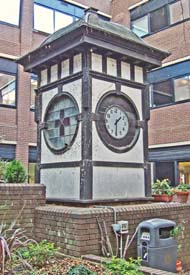
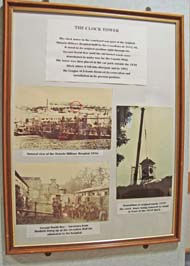
The only part of the original Hospital to survive is the Clock Tower (left). A panel in the foyer of the Canada Wing explains its rescue from destruction (right).
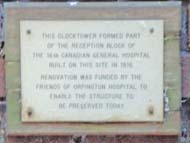
A plaque mounted on the wall nearby states that renovation and preservation of the Clock Tower was funded by the Friends of Orpington Hospital in 1993.
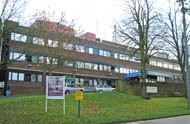

The Canada Wing.

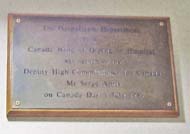
Plaques placed above doorways in the foyer indicate a continuing link with Canada. The Canada Wing was officially opened by the High Commissioner for Canada on 26th July 1983 (left), while the Out-Patients Department of the Wing was opened by the Deputy High Commissioner for Canada on Canada Day (1st July) in 1994 (right).
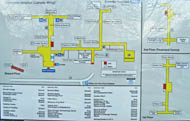
Site plan for the Orpington Hospital.
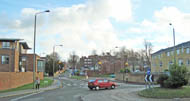

Harris HospisCare is located in Tregony Road, at the foot of the drive.
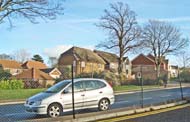
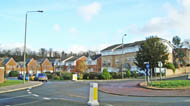
New housing has been built to the northwest of the Hospital.
During WW1 the churchyard of the All Saints' Church was extended by adding land from the grounds of Bark Hart House. The extension was dedicated to those servicemen who had died of their injuries at the Ontario Military Hospital. It is known as the Ontario Cemetery or the 'Canadian Corner' and contains 116 graves, 88 of which are Canadian, 8 Australian and 23 British. A further 14 graves were added during WW2.
The site contains a War Memorial and a Garden of Remembrance, and is cared for by the Commonwealth War Graves Commission.
(Author unstated) 1915 Care of the wounded. British Journal of Nursing, 28th August, 174.
(Author unstated) 1921 The Ministry of Pensions Hospital, Orpington. The Aftermath. British Journal of Nursing, 27th August, 133.
http://bnatopics.org
http://en.wikipedia.org
http://rcnarchive.rcn.org.uk
www.bromleyhospitals.nhs.uk
www.canadiangreatwarproject.com
www.cbc.ca
www.cwgc.org
www.geograph.org.uk (1)
www.geograph.org.uk (2)
www.hospitalartstudio.co.uk
www.kentvad.org
www.legion-magazine.co.uk
www.mikeshaw.co.uk
www.nursingtimes.net
Return to home page